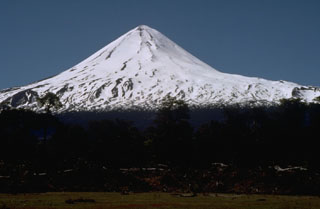Report on Llaima (Chile) — 23 January-29 January 2008
Smithsonian Institution / US Geological Survey
Weekly Volcanic Activity Report, 23 January-29 January 2008
Managing Editor: Sally Sennert.
Please cite this report as:
Global Volcanism Program, 2008. Report on Llaima (Chile) (Sennert, S, ed.). Weekly Volcanic Activity Report, 23 January-29 January 2008. Smithsonian Institution and US Geological Survey.
Llaima
Chile
38.692°S, 71.729°W; summit elev. 3125 m
All times are local (unless otherwise noted)
SERNAGEOMIN reported that eruptive activity at Llaima continued from the main crater and from multiple areas on the E flank during 23-27 January. On 23 January, a brown ash plume rose to an altitude of 3.5 km (11,500 ft) a.s.l and drifted W. Based on observations during an overflight later that day, Strombolian eruptions took place from a central pyroclastic cone in the main crater and were accompanied by emissions of brown ash. A small hornito emitting bluish gas and a lava field were noted between the pyroclastic cone and the inner margins of the crater.
On 24 January, explosions from the E flank were detected and on 26 January, steam plumes were observed. Strombolian eruptions in the main crater accompanied by gas and ash emissions continued during 24-27 January. Ash plumes rose to altitudes of 3.3-4.1 km (10,800-13,500 ft) a.s.l. and drifted NW, E, SE, and S.
Geological Summary. Llaima, one of Chile's largest and most active volcanoes, contains two main historically active craters, one at the summit and the other, Pichillaima, to the SE. The massive, dominantly basaltic-to-andesitic, stratovolcano has a volume of 400 km3. A Holocene edifice built primarily of accumulated lava flows was constructed over an 8-km-wide caldera that formed about 13,200 years ago, following the eruption of the 24 km3 Curacautín Ignimbrite. More than 40 scoria cones dot the volcano's flanks. Following the end of an explosive stage about 7200 years ago, construction of the present edifice began, characterized by Strombolian, Hawaiian, and infrequent subplinian eruptions. Frequent moderate explosive eruptions with occasional lava flows have been recorded since the 17th century.
Source: Servicio Nacional de Geología y Minería (SERNAGEOMIN)

